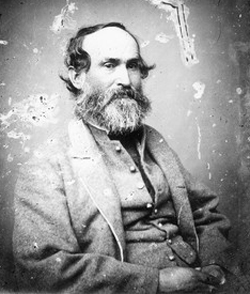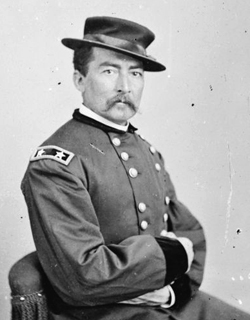Battle of Fisher’s Hill • Tour the Battlefield • 1864 Shenandoah Timeline

Tour the Fisher’s Hill battlefield
One small monument and a handful of wayside markers interpret the history of the battlefield, much of which is little changed since 1864.
Who fought in the Battle of Fisher’s Hill?
The Confederate Army of the Valley, about 9,500 men under Lieutenant General Jubal Early, versus
The Federal Army of the Shenandoah, about 29,500 men under Major General Philip Sheridan.
 Lieutenant General Jubal A. Early |
 Major General Philip Sheridan |
When was the Battle of Fisher’s Hill fought?
The battle was fought on September 21-22, 1864. It was part of the Shenandoah Valley Campaign of 1864.
Where was the Battle of Fisher’s Hill?
The battlefield is two miles southwest of Strasburg, Virginia. It is about 19 miles south of Winchester, Virginia, 71 miles west of Washington, D.C., and 112 miles in a direct line (165 miles by highway around the mountains) from Richmond.
The Shenandoah Valley here is split in two by 40 mile long Massanutton Mountain, which is crossed by only one steep pass halfway down its length. At Fisher’s Hill the northern valley narrows to only about four miles. A stream, Tumbling Run, comes down out of the west. It carves a ravine on the north side of a steep-fronted ridge known as Fisher’s Hill. The position was a natural fortress for an army defending against an attacker from the north. As Union forces began to gather on the other side of Tumbling Run they were in agreement that direct assault would be impossible.
Why was the battle fought?
In June Early had been given the mission of creating a diversion in the Shenandoah Valley. By threatening Washington he would draw Union forces away from the Siege of Petersburg and the fighting around Richmond. He succeeded, drawing two Federal infantry corps and two cavalry divisions away from the forces slowly strangling Lee.
Sheridan had been given command of Union troops in the Shenandoah Valley. His mission was to eliminate Early. After a month of delays he had made a fair start of it. In the Third Battle of Winchester on September 19, after a hard-fought battle the Confederate defences collapsed in headlong retreat. Early had reformed just twenty miles south on Fisher’s Hill. He hoped he could use the excellent defensive position to hold off Sheridan or force him into a costly frontal assault.
But there was a weakness. Early didn’t have enough men to fully man the four mile length of the line. He ran out of infantry about a mile short of the mountains on the west and was forced to string out dismounted cavalry to cover the gap. Early didn’t have much confidence in his cavalry, but he hoped Federal forces would not be able to move through the broken, rising, heavily wooded country on his far flank.
The Federal Plan
Federal Major General George Crook recognized the Confederate weakness. His Eighth Corps troops had spent the war campaigning in the mountains of West Virginia. They would not be put off by the high ground on the flank. He went to Sheridan with a plan for the main army to threaten the headon attack Early was hoping for while Crook’s men quietly picked their way around his flank. When Crook erupted on Early’s flank and rear the the main army would also attack, taking the Confederates from two sides.
Crook’s plan was opposed by Union Sixth Corps commander Horatio Wright. He believed his troops, detached from the Army of the Potomac and veterans of a far harder school than Crook’s West Virginians, should lead the attack. But Crook had an advantage in selling the plan to Sheridan. The two had been roomates and good friends at West Point. Sheridan not only approved Crook’s plan, in the future he would take full credit for it, destroying their friendship.
The battle
Crook’s attack went exactly as planned. When his men came boiling off of the mountain slope Early’s cavalry dissolved. As Crook rolled up Early’s flank the rest of Sheridan’s army attacked from in front. Knots of infantry put up reistance as they were struck end-on. But when threatened from two sides and still out of sorts from their rout two days earlier, they also took to the rear.
Sheridan’s victory was not complete. After an all-day climb over mountain back trails Crook’s exhausted infantry could not keep up the pursuit. Two of Sheridan’s cavalry divisions had been sent to the other side of Masanutton Mountain to make a wide swing into Early’s rear, but were turned back. The cavalry division Sheridan kept with the army was ordered by its commander, William Averell, to stop the pursuit at nightfall. The decision would cost him his command, but Early was able to save the remnant of his army.
How many casualties were there in the Battle of Fisher’s Hill?
Only 81 men were killed at Fisher’s Hill – 30 Confederates and 51 Federals. Early lost 200 men wounded and Sheridan over 400. The great loss for the Confederates was over 1,000 men and 14 guns captured.
What was the significance of the Battle of Fisher’s Hill?
For the second time in three days the Jubal Early’s Confederate army collapsed and fled the field. Sheridan had further battered the already outnumbered and badly hurt Confederates. Early was forced to fall back 75 miles up the Valley to Waynesboro, where he could slip across Rockfish Gap and out of the Valley if necessary. This left the Valley as far south as Staunton open for the next stage in Grant’s strategy: The Burning. Crops and cattle, barns and mills, all would be carried off or put to the torch to eliminate the Shenandoah Valley once and for all in its role as the breadbasket of the Confederacy.
Twice beaten, Early’s army seemed eliminated as a military force – until he reappeared out of the early morning fog over Cedar Creek less than a month later.
